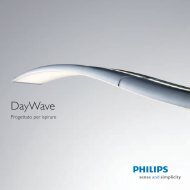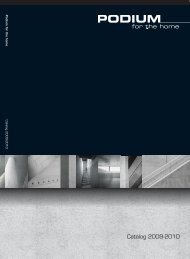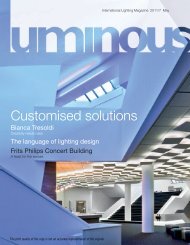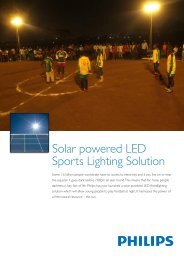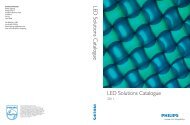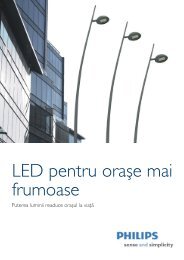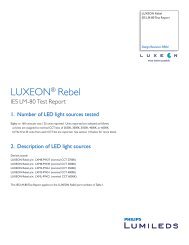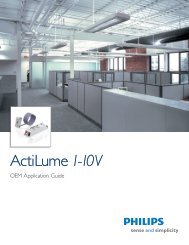LLC7120/00 Chronosense Controller - Philips Lighting
LLC7120/00 Chronosense Controller - Philips Lighting
LLC7120/00 Chronosense Controller - Philips Lighting
You also want an ePaper? Increase the reach of your titles
YUMPU automatically turns print PDFs into web optimized ePapers that Google loves.
<strong>LLC7120</strong>/<strong>00</strong><br />
<strong>Chronosense</strong> <strong>Controller</strong><br />
36<br />
4.2<br />
Dimensions in mm<br />
05<br />
102.5<br />
85<br />
112.5<br />
M8<br />
30.5 48<br />
Product details<br />
• The <strong>Chronosense</strong> is a device intended for integration in an outdoor<br />
type luminaire (street lighting, area lighting etc.) or to fit in a gear<br />
tray that is mounted at the bottom of a pole.When mounted at the<br />
bottom of a pole extra measures should be taken to protect the unit<br />
against moisture.<br />
• The <strong>Chronosense</strong> is a mains powered device and is using a changeover<br />
relay to enable step-dimming.<br />
• The <strong>Chronosense</strong> has an automatic switch-over function built in to<br />
enable the ‘dim down’ and ‘dim up’ functionality.<br />
This can be used during the period of the night with a relative<br />
low traffic density in order to save energy while maintaining a<br />
homogeneous spread of light.<br />
• To establish the hours on which it should operate, the <strong>Chronosense</strong><br />
counts the hours that the power of the lights was turned on and<br />
calculates a midpoint. It uses the midpoint of the power-on period as<br />
a time reference point.<br />
Note: Power on is more or less sun down, power off is more or less<br />
sunrise, but the midpoint of the power-on period is not the same as<br />
midnight (<strong>00</strong>:<strong>00</strong>)<br />
• At power up the unit stays at 1<strong>00</strong>% level for 10 minutes (warm-up<br />
time of the lamp).<br />
• The dim down times and the dim up times are specified as the hours<br />
before and the hours after the calculated midpoint.<br />
• The <strong>Chronosense</strong> calculates the midpoint of the power-on period by<br />
half of the last known “On-time” value.<br />
• When the <strong>Chronosense</strong> is connected for the first time, it needs to<br />
synchronize for 2 days before it starts dimming.<br />
If an unusually large deviation between the measured times occur<br />
(i.e. power disruption), the <strong>Chronosense</strong> stops dimming and<br />
resynchronizes during the next 2 days. After that it will again operate<br />
as set.<br />
• The available dipswitches can be used to:<br />
1 Set the time that the <strong>Chronosense</strong> should dim down;<br />
2 Set the time that the <strong>Chronosense</strong> should dim up;<br />
3 Activate test mode.<br />
1/4
<strong>LLC7120</strong>/<strong>00</strong><br />
<strong>Chronosense</strong> <strong>Controller</strong><br />
Technical Data<br />
General<br />
The dim control signal activates a relay switch-over contact for dimming<br />
purposes.The relay contact output is intended to be used in combination<br />
with a conventional extra “dim” ballast or a multi-wattage ballast.<br />
There is no thermal overload protection.<br />
The <strong>Chronosense</strong> is mounted in a housing with classification IP20.<br />
A HID-lamp must be reignited, even after a short mains power failure.<br />
The <strong>Chronosense</strong> is equipped with a circuit that enables it to detect<br />
short power interruptions, so appropriate measures can be taken in cases<br />
of a short power failure.<br />
The <strong>Chronosense</strong> accepts “Power-on” time periods between 4 and 22<br />
hours. Shorter or longer time periods are ignored.The <strong>Chronosense</strong><br />
synchronizes (stops dimming) if the difference between the last recorded<br />
time period and the average of the previous ones is more than 1 hour.<br />
Application<br />
• The <strong>Chronosense</strong> is designed for electro-magnetic ballasts for<br />
70-4<strong>00</strong> W SON (-T) lamps as well as any other step-dim solution<br />
where a switch from one circuit to another circuit is required.This<br />
can include features like switching off the light in a certain period of<br />
the night or switching LED drivers in or out.<br />
• The unit is to be placed inside an outdoor luminaire or at the bottom<br />
of a lamp post in a suitable enclosure (at least IP54).<br />
Mains input<br />
• Single-conductor terminal block,<br />
• Wire diameter 0,5-1,5mm 2 “s”,AWG 20-14<br />
• Strip length: 9-10mm<br />
• 220-240V ±10%, 50Hz<br />
• Power dissipation < 0,8W over full voltage and temperature range<br />
Output<br />
• Change-over switch (SPDT). Gold plate silver alloy contacts.<br />
• Varistor between C and NC<br />
• Single-conductor terminal block,<br />
• Wire diameter 0,5-1,5mm 2 “s”,AWG 20-14<br />
• Strip length: 9-10mm<br />
• Maximum continuous load current 6.5 A.<br />
• Maximum inrush current of connected load 16 A (t = 10 ms, 50%).<br />
• Maximum peak voltage generated by load at switch-off: 750 V.<br />
Environmental conditions<br />
Operating conditions<br />
Temperature -30°C … +75°C<br />
Test point temperature on case 80 °C<br />
Humidity 10 ... 90 % RH<br />
Storage conditions<br />
Temperature -40°C … +85°C<br />
Humidity 5 ... 95 % RH<br />
RFI < 30 MHz CISPR 15 ed 7.1<br />
RFI > 30 MHz CISPR 15 ed 7.1<br />
Immunity IEC 61547<br />
Safety IEC 61347-2-11; IEC60598-1<br />
Vibration & bump tests IEC 6<strong>00</strong>68-2-6-FC; IEC 6<strong>00</strong>68-<br />
2-29-Eb<br />
Approval marks ENEC, CE marking<br />
Dimensions (see picture)<br />
L x W x H 112.5 x 48 x 30.5 mm<br />
(with M8 bold)<br />
L x W x H 102.5 x 48 x 30.5 mm<br />
(without M8 bold)<br />
Fittings (see picture)<br />
1 By means of the bold (M8x10).<br />
2 By means of 2 fasteners.Thread outer diameter 4mm (M4).<br />
36<br />
4.2<br />
Fitting dimensions in mm<br />
102.5<br />
Weight: 80 grams<br />
Packing: 48 pieces stacked in outer box<br />
112.5<br />
85<br />
M8<br />
30.5 48<br />
2/4
<strong>LLC7120</strong>/<strong>00</strong><br />
<strong>Chronosense</strong> <strong>Controller</strong><br />
Factory default settings<br />
Dipswitch<br />
The <strong>Chronosense</strong> has a six position dipswitch to set the mode of<br />
operation (test/normal) and dim period.<br />
Dipswitch 1,2 and 3 are used to set the dim hours before midpoint of<br />
the night (t1)<br />
Dipswitch 4 and 5 are used to set the dim hours after midpoint of the<br />
night (t2)<br />
Dipswitch 6 is used to set the mode of operation.<br />
At factory default, all dipswitches are set to OFF:<br />
• Dim down before midnight: 3:30<br />
• Dim up after midnight: 5:30<br />
• Test mode: OFF<br />
on<br />
1 2 3 4 5 6<br />
Dipswitch lay out and factory setting.<br />
Typical connection diagrams<br />
L<br />
BSD BSN<br />
Incorrect wiring can damage the unit<br />
Series<br />
ignitor<br />
L N<br />
220-240V 50Hz<br />
Wiring diagram of <strong>Chronosense</strong> in combination with an additional dim<br />
ballast<br />
L<br />
BSD BSN<br />
Incorrect wiring can damage the unit<br />
Semi<br />
parallel<br />
ignitor<br />
L N<br />
220-240V 50Hz<br />
Wiring diagram of <strong>Chronosense</strong> in combination with semi-parallel ignitor<br />
system<br />
Adjustments<br />
By adjusting the dipswitch setting, the dim down and dim up times can<br />
be altered.The dim down and dim up hours are defined relative to the<br />
midpoint of the night.This is not necessarily <strong>00</strong>:<strong>00</strong> hours. Please check the<br />
value for your country.<br />
Switch number 1 2 3 Dim down before midpoint<br />
Position off off off 3:30<br />
off off on 3:<strong>00</strong><br />
off on off 2:30<br />
off on on 2:<strong>00</strong><br />
on off off 1:30<br />
on off on 1:<strong>00</strong><br />
on on off 0:30<br />
on on on 0:<strong>00</strong><br />
Switch number 4 5 Dim down after midpoint<br />
Position off off 5:30<br />
on off 5:<strong>00</strong><br />
off on 4:30<br />
on on 4:<strong>00</strong><br />
The <strong>Chronosense</strong> is also provided with a test mode to check<br />
functionality within the factory (switch 6).<br />
Switch number 6 Mode<br />
Position off (Normal use)<br />
on every minute dimming for 5 seconds<br />
L<br />
Phigh<br />
PLow<br />
Incorrect wiring can damage the unit<br />
Series<br />
ignitor<br />
L N<br />
220-240V 50Hz<br />
Wiring diagram of <strong>Chronosense</strong> in combination with a multi-wattage ballast<br />
3/4
<strong>LLC7120</strong>/<strong>00</strong><br />
<strong>Chronosense</strong> <strong>Controller</strong><br />
Example <strong>Chronosense</strong><br />
An owner of a lighting installation wants to decrease the use of energy<br />
and chooses to optimize on the winter period.<br />
His/her desire is to dim down at 22.<strong>00</strong> and stop dimming at around 5:<strong>00</strong><br />
in the morning.<br />
In order to choose the dipswitch settings to realize this request the next<br />
steps are followed:<br />
• Take the switch on/switch off times off the lighting installation on the<br />
longest night of the year (Europe: 21 December). In example 16:45<br />
switch on and 8:15 switch off.<br />
• Calculate the midpoint (in example 0:30).<br />
• Calculate the numbers of hours before midpoint (= midpoint minus<br />
desired start dim time). In example 2 hours and 30 minutes (2:30).<br />
• Calculate the number of hours after midpoint (= desired stop dim<br />
time minus midpoint). In example 4 hours and 30 minutes (4:30).<br />
1<strong>00</strong>%<br />
80%<br />
60%<br />
40%<br />
20%<br />
Packing data<br />
Type Box dimensions Qty Material Weight (Kg)<br />
(mm) net gross<br />
Outer Box (48 pcs.) 355 x 276 x 110 1 cardboard 3.84 4.4<br />
Ordering Data<br />
Type MOQ Ordering number EAN code level 1 EAN code level 3 EOC<br />
<strong>LLC7120</strong>/<strong>00</strong> 48 9137 <strong>00</strong>3 34903 n.a. 87279 <strong>00</strong>868142 868142 <strong>00</strong><br />
322 636 36090<br />
10/2<strong>00</strong>9<br />
Data subject to change<br />
www.philips.com/lightingcontrols<br />
• Look up the required dipswitch setting.<br />
• Take the hours of the shortest night in the year (Europe 21 June) and<br />
check whether the resulting dim down/ dim up hours are acceptable<br />
in summer time (daylight saving time). Midpoint may change an hour<br />
in case of winter/summer time adjustment.<br />
on<br />
1 2 3 4 5 6<br />
Hours before midpoint 2.5 (2:30)<br />
Hours after midpoint 4.5 (4:30)<br />
Normal operation<br />
Note 1: In this example the lights in the summer are switched off earlier<br />
then the unit stops dimming.The unit is able to handle these situations.<br />
Note 2: The mains power should be switched on and off normally.<br />
0%<br />
ON OFF<br />
12:<strong>00</strong> 14:<strong>00</strong> 16:<strong>00</strong> 18:<strong>00</strong> 20:<strong>00</strong> 22:<strong>00</strong> <strong>00</strong>:<strong>00</strong> 2:<strong>00</strong> 4:<strong>00</strong> 6:<strong>00</strong> 8:<strong>00</strong> 10:<strong>00</strong> 12:<strong>00</strong><br />
Longest night of the year<br />
16:30 22:<strong>00</strong> <strong>00</strong>:30<br />
5:<strong>00</strong><br />
Daylight saving time<br />
8:30<br />
1<strong>00</strong>%<br />
80%<br />
60%<br />
40%<br />
20%<br />
0%<br />
ON OFF<br />
12:<strong>00</strong> 14:<strong>00</strong> 16:<strong>00</strong> 18:<strong>00</strong> 20:<strong>00</strong> 22:<strong>00</strong> <strong>00</strong>:<strong>00</strong> 2:<strong>00</strong> 4:<strong>00</strong> 6:<strong>00</strong> 8:<strong>00</strong> 10:<strong>00</strong> 12:<strong>00</strong><br />
Shortest night of the year<br />
22:<strong>00</strong> 23:<strong>00</strong> 1:30<br />
5:<strong>00</strong><br />
4/4




